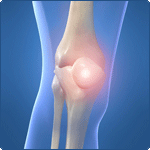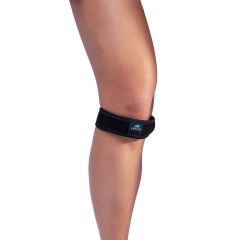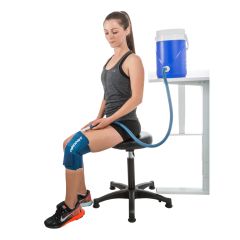Patellar Tendonitis / Jumper's Knee

Jumper's knee, or patellar tendonitis, is a painful condition that is often caused by repetitive movements and is common in many athletes. Jumper's knee is one of the most common types of knee pain, and it can easily be treated. Before we explain the condition, we first need to talk about the construction of the knee. There are two main tendons that allow the knee to have the range of movement that it does - the quadriceps tendon and the patellar tendon, which connect the muscles to the bones, and allow people to straighten and bend their legs. The patellar tendon is the ligament that attaches the shin bone (tibia) to your kneecap (patella). This tendon helps allow movement to the lower leg muscles and is used when jumping, pedaling, and kicking. When the patellar tendon is overused, it can cause inflammation known as patellar tendonitis (also known as patellar tendinitis or jumper's knee). If not treated immediately, the continued stress in this area of the knee can cause minor tears and further inflammation.
Causes of Patellar Tendonitis
The most common cause of patellar tendonitis is overuse, which is why it is often seen in athletes, who tend to use a lot of repetitive movements that involve running and jumping, which is why it is sometimes called jumper’s knee. It is commonly seen in sports that required jumping such as basketball or volleyball. These repetitive movements can cause micro-tears as well as collagen degeneration in the tendon. Sudden addition or change to the amount or intensity of your workouts can also increase your chances of patellar tendonitis. Running on hard surfaces and weak muscles around the knee may increase your risk as well. Less common causes for patellar tendonitis include genetic predisposition (such as with knees that are misaligned) or through direct injury to the patellar tendon. Jumper's knee can also be caused by not properly taking care of a serious injury to the tendon, but overuse is much more common for the condition.
Symptoms of Patellar Tendonitis
Patients suffering from patellar tendonitis typically feel pain in the front of the knee below the kneecap, which is where the patellar tendon is located. Pressing on this area may cause additional discomfort. During activities such as jumping or running, you may feel sharp pain that persists even after working out. Some people also experience tightness of the knee and a "squeaking" sensation when moving. It is fairly easy to diagnose jumper's knee. All a physician needs to do is to press on the affected area, and if the patient displays the right symptoms, he or she more than likely has jumper's knee. Many people with jumper's knee complain of pain when they are doing certain activities, such as running, jumping, kneeling and going up and down stairs. Sometimes, there is inflammation around the patellar tendon. To make sure that the tendon is not degenerating, an MRI may be performed, as well as x-rays, to make sure there are no bone spurs, which are associated with jumper's knee.
What Can Be Done?
If you think you are suffering from patellar tendonitis it’s best to discuss your symptoms with your doctor. Most patellar tendonitis can be treated without surgery, though it may be recommended for patients with severe conditions.
Rest
The first thing to do when diagnosed with Jumper's Knee is to rest the affected knee as much as possible. If you are an athlete, it is recommended to stop playing sports until the tendon is completely healed. Otherwise, the tendons may start healing and get re-aggravated when you start your activity. Most times, the patient is the best judge of how much rest his or her knee requires, and the majority of people are going to take it easy as long as needed to make sure that they have no problems with their knees in the future.
Anti-Inflammatory Pain Relief
Anti-inflammatory medications are often prescribed to patients with jumper's knee to help with pain relief and inflammation.
Cold Therapy
Cold therapy (icing the knee) and massage therapy may also be recommended. Ice is important for helping alleviate pain and reducing inflammation. Try 15 minutes on and 15 minutes off, repeat 2-3 times daily.
Stretching & Rehab Exercises
Keeping the knee ligaments loose and flexible will help your patellar tendon as it engages in activity. A key factor in healing is strengthening the leg muscles that support the areas around the knee. In order to strengthen the knee and surrounding ligaments and tendons, it is important to follow through with knee strengthening exercises a few times each week, as well as stretching exercises that will help to strengthen the tendon.
Bracing & Support
Many patients with patellar tendonitis need to wear a brace to support the patellar tendon. These braces for jumper's knee work by applying pressure to the tendon to help alleviate pain. Generally, patellar tendon braces come in the form of knee straps but there also many other types. Two commonly recommended braces are the Webtech Knee Strap or the Anaform Pinpoint Knee Strap. Both help relieve patellar tendonitis pain without restricting movement. As long as patients follow their physician's advice properly, there is no reason why the knee should not heal completely. Then, they will be able to take part in all of their normal activities, including the sports they love so much.
As with any injury, your doctor will be the best source of advice on the appropriate treatment method for your situation. Regardless of which path of recovery is selected, time is necessary to heal from patellar tendonitis.
Protection & Support for Patellar Tedonitis / Jumper's Knee
View All Patellar Tendonitis Braces






